What Is First Person Point of View
First person point of view is where the writer (or fictional narrator) relates information from their own perspective. Whether they're telling a story from their past or giving you their opinion of the present, if the main pronoun in a piece of writing is 'I,' you're probably dealing with something written in the first person.
A passage written in the first person point of view might look something like this:
I feared what might greet me as I entered the kitchen. Something was about to happen. I couldn't quite put my finger on what made me so sure, but it was a certainty unlike anything I had ever experienced before.
As a way of writing that seemingly never goes out of fashion, first-person POV is something that all authors should strive to master. That's why we've enlisted the help of our Reedsy editors to put together this guide to the first person point of view.

Why first person is such a powerful POV
First person narration brings readers directly into the story, experiencing its events as the POV character. It can lend authority and credibility to a tale, and has plenty of other useful storytelling functions. While it may not perfectly suit every story — hence why we also have second person and third person alternative — it's definitely a popular POV, and one that's important for authors to master. Here's a little more on why first person is worth learning to write well.
It creates an immersive experience
One of the main benefits of first person POV is what is sometimes referred to as the 'close psychic distance' between the reader and the character. That is, many authors and readers prefer first-person-POV writing because it creates intimacy. Tracy Gold, Reedsy editor and Adjunct Professor of Composition at the University of Baltimore, corroborates this:
Writing first person makes it easier to get deep inside a character's thoughts and feelings. With first person, the writer or reader becomes the character as they get deeper into the story, and that's the kind of immersive experience that makes me love a book.
That's not to say that second person POV or third person POV can't create intimacy, but first person tends to be the most intimate, as you're getting direct access to the character's internal thoughts and feelings. There's often a sense of honesty and trust that first person narration can communicate, pulling the reader into the story by evoking empathy.
In nonfiction, a first-person voice can also lend credibility to the writing: "I know this to be true, because I actually saw or did these things." Readers get to relive the experience through a primary source, safe in the knowledge that this person knows what they're talking about.
Of course, neither fiction nor nonfiction is immune to the phenomenon of unreliable narrators (more on this below), as real people are just as likely to suffer from biases as fictional ones.
Example: Great Expectations by Charles Dickens
Dickens' classic, about a young boy born into poverty hoping to improve his station in life in order, showcases the immersive effect and intimacy that a first person POV can offer 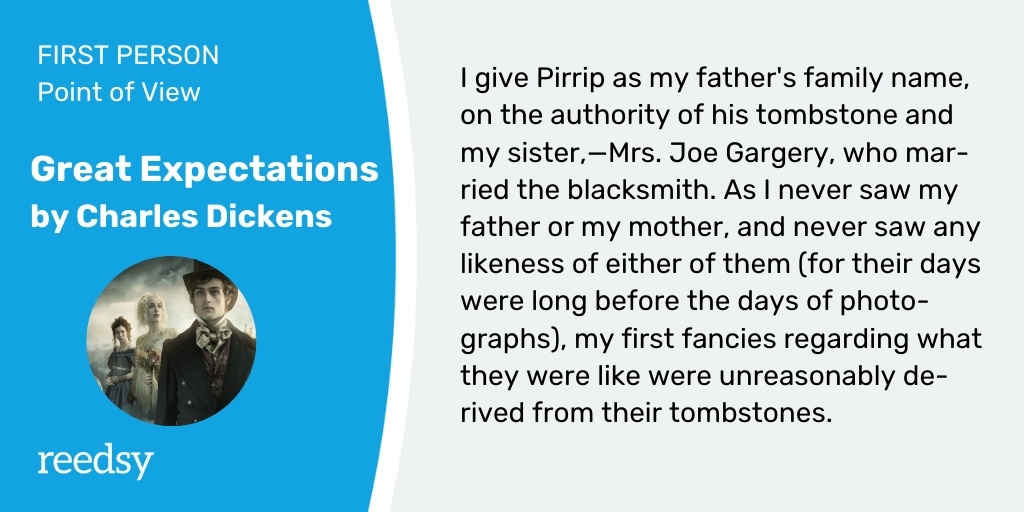 Told in Pip's voice, this early passage deftly captures his internal conflict over his identity, which drives much of the novel's plot. Because we can follow his thought process from start to finish, we understand why he makes the decisions he does, however imperfect they may be.
Told in Pip's voice, this early passage deftly captures his internal conflict over his identity, which drives much of the novel's plot. Because we can follow his thought process from start to finish, we understand why he makes the decisions he does, however imperfect they may be.
First person can foster an intriguing unreliable narrator
First person narratives also excel in establishing intrigue and questions about the true nature of the narrator — are they representing an objective truth or are they pulling the wool over our overly trusting eyes?
As most first person POVs are inherently limited by the biases and personal motivations of the narrator, authors can easily create intrigue through unreliable narrators who turn the concept of honesty and trust on its head. An unreliable narrator makes the reader second-guess whether the narrator is telling the entire story — which is extra-exciting if you only find out they're unreliable partway through the tale.
While this lack of credibility can be fatal in non-fiction, it can be a real delight in fiction. Aja Pollock — an editor who has worked on books by writers like Neil Gaiman, George W. Bush, and more — summarizes it well:
When the narrator has questionable credibility, it keeps the reader guessing about the gap between reality and the observations of the POV character. Unreliable narrators can be tricky to pull off for inexperienced writers (or even experienced ones) — but they add an extra layer of mystery and tension that keeps those pages turning.
Example: Never Let me Go by Kazuo Ishiguro
In this subtly dystopian novel about a group of students at Hailsham, a fictional English boarding school, Ishiguro uses the first person point of view to play with the concept of reliable and unreliable narration through an exploration of memory. 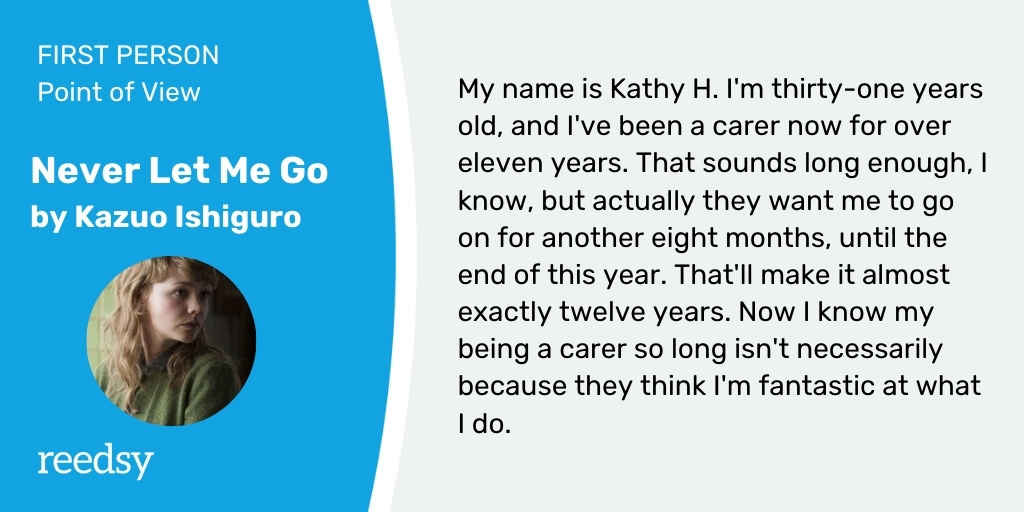 In this passage, Kathy reveals that she's become privy to new knowledge that has changed her perception of the past. But she's not telling us what that knowledge entails. By slowly letting more doubt creep into the story, Ishiguro explores the fickle nature of memory, creating a creeping sense that there's more to Hailsham than meets the eye. Readers will start to question not only the picture that Kathy paints, but their own ability to separate truth from reality, making for an exceptionally intriguing reading experience.
In this passage, Kathy reveals that she's become privy to new knowledge that has changed her perception of the past. But she's not telling us what that knowledge entails. By slowly letting more doubt creep into the story, Ishiguro explores the fickle nature of memory, creating a creeping sense that there's more to Hailsham than meets the eye. Readers will start to question not only the picture that Kathy paints, but their own ability to separate truth from reality, making for an exceptionally intriguing reading experience.
Its perceived limitations can inspire creativity
What may seem like a limitation of first person POV — that you only get one person's perspective on a story at a time — can actually be an opportunity to get creative. Maybe you decide to tell the story from the POV of a bystander (which would address the issue of neutrality), a pet, multiple characters with conflicting memories, or even an all-knowing god-like figure.
First person omniscient
First person omniscient is when a first-person narrator is privy to the thoughts, actions, and motivations of other characters. It's what one might describe as an exception to the rule of first person narration — and it's a rare one at that, in part because it's tricky to pull off and in part because it doesn't feel very realistic.
However, there are certain cases where first person omniscient narration is relevant and interesting. One such example is Markus Zusak's The Book Thief, in which the first person omniscient narrator is (spoiler alert) Death itself. Another well-known example is Lemony Snicket's A Series of Unfortunate Events — the narration is first-person and has a very distinctive voice, yet the narrator always seems to know what's going on with all the characters.
The prose style is character-driven
Another characteristic of successful first person narratives is that the entire tone and style is dictated by who the narrator is: their worldviews, motivations, and vices. Not only does every plot point reveal something new about them, but the prose itself is deeply informed by their unique character.
Example: The Adventures of Huckleberry Finn by Mark Twain
A particularly illuminating example of how the first person POV can help establish tone and style is Mark Twain's Huckleberry Finn — a novel in which a young boy recounts his adventures on the Mississippi River, together with a runaway slave. 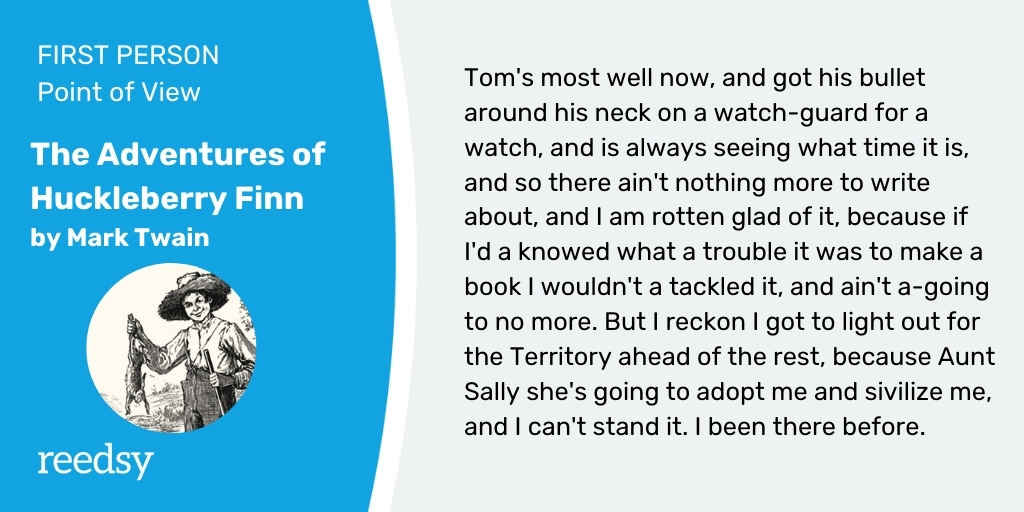 Told from Huck's POV and in his own language, this passage manages to capture not only the narrator's childlike spirit, but a sense of time and place which sets the account apart from others. These evocations remain strong throughout the novel, and indeed have become a hallmark of Huckleberry Finn in the many years since it's been published.
Told from Huck's POV and in his own language, this passage manages to capture not only the narrator's childlike spirit, but a sense of time and place which sets the account apart from others. These evocations remain strong throughout the novel, and indeed have become a hallmark of Huckleberry Finn in the many years since it's been published.
An outsider narrator can offer an illuminating view
Though many first person POV stories are focused on the inner lives of their narrators, sometimes the first person narrator isn't actually the key character that the story revolves around. Instead, they're simply the lens through which we view everything.
In a story told in third person, they might have been a side character, but here they get to tell us their version of events. And if they're not personally involved in the conflict, they may actually be free of some of the biases that first person narrators usually get saddled with. So while the reader gets an inside perspective of the narrator's mind, they also get an outside view of key events and characters. Some would call that the best of both worlds.
Example: To Kill a Mockingbird by Harper Lee
To Kill a Mockingbird — an account of the trial of a Black man accused of raping a white woman in the 1930s American South — is narrated by a woman called Scout, looking back on the experiences of her 6-year-old self. 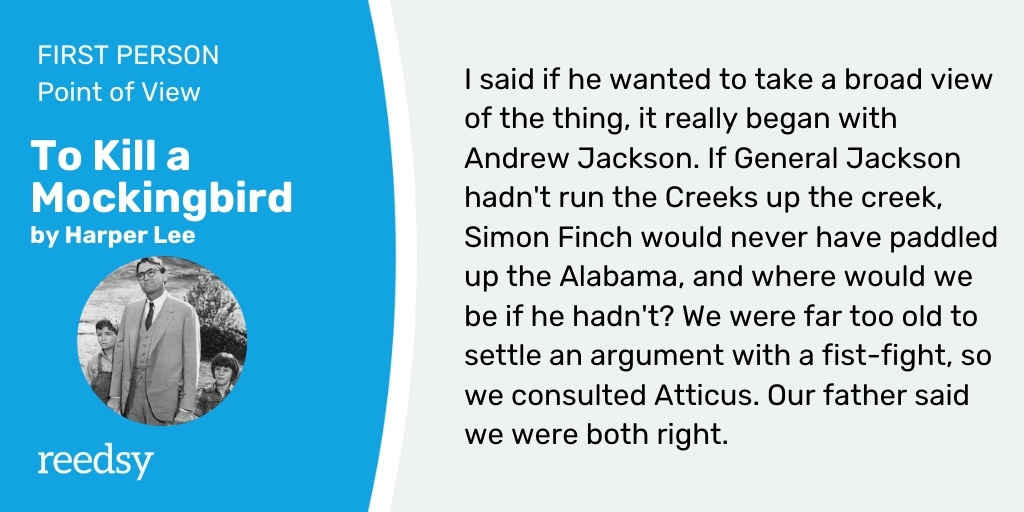 While young Scout is certainly central to the novel in many ways and filters the impressions the readers receive, the real drama unfolds in the courtroom and the world of the adults — a world she will only understand when she herself is grown up. Here we see how much Scout respects and values the opinion of her father Atticus — a hint at how he will serve as the story's strong moral compass, even when others in the town turn against him.
While young Scout is certainly central to the novel in many ways and filters the impressions the readers receive, the real drama unfolds in the courtroom and the world of the adults — a world she will only understand when she herself is grown up. Here we see how much Scout respects and values the opinion of her father Atticus — a hint at how he will serve as the story's strong moral compass, even when others in the town turn against him.
🖊️
Which POV is right for your book?
Take our quiz to find out! Takes only 1 minute.
Common mistakes when writing first person
Writing in first person may be one of the first things we learn as children, but like any narrative technique, it comes with its own set of challenges. And though challenges can often provide opportunities for creativity, it's still crucial to know how to handle the pitfalls and clichés outlined below.
1. Lazily all-knowing narrators
One of the first problems that authors will encounter when they decide to write in first person is the issue of scope — how much can the narrator actually know about what is going on? Aja Pollock explains:
If first-person narration discusses the interior life of another character, it has to be couched as the POV character's speculation or perception — not as absolute knowledge of what the other character is thinking or feeling.
You might see this as a roadblock if, in a particular scene, you want to show what a secondary character is thinking. However, as Pollock notes, your narrator can always indicate what other characters are feeling with a small observation. You might want to write:
I told Karen what I'd heard. She was nervous at the news.
Of course, your first-person narrator can't know what Karen is feeling (unless they are literally a psychic), but to convey the same idea, you might write:
As I told her the news, Karen looked away nervously.
Example: Room by Emma Donoghue
Narrated from a child's POV, Room uses the first person to create a sense of mystery and intrigue for the reader. 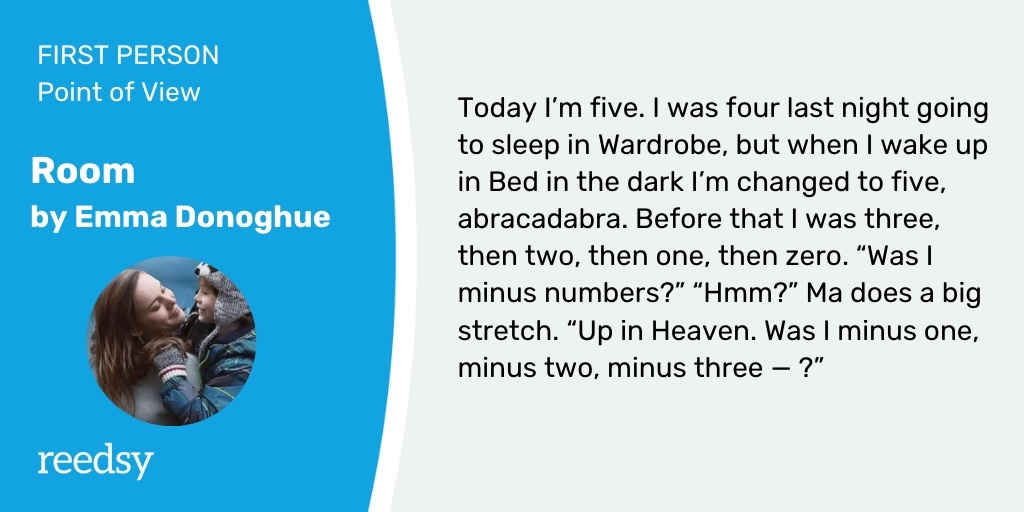 The incredibly limited scope and understanding that Jack, the 5-year-old narrator, exhibits forces the reader to search for clues to piece the puzzle together themselves. It also adds a mitigating layer of innocence to an otherwise bleak narrative, and serves as a strong contrast to the depiction of evil.
The incredibly limited scope and understanding that Jack, the 5-year-old narrator, exhibits forces the reader to search for clues to piece the puzzle together themselves. It also adds a mitigating layer of innocence to an otherwise bleak narrative, and serves as a strong contrast to the depiction of evil.
2. Alternating narrators who sound the same
First person point of view doesn't mean that you have to stick to the same person's first-hand account throughout your novel. Many popular novels, particularly young adult novels, actually employ multiple first-person narrators to broaden their scope a little bit. When done right, this adds variety and layers of complexity to your storytelling which readers will greatly enjoy. But it can also be tricky to pull off, as readers may get characters confused.
First person appeals to many first-time authors as it allows them to use their personal, real-world voice. But if all the narrators in a writer's story share the same quirky turns of phrase, then you might run into trouble. So make sure that you give each character a distinct voice and style that allows them to feel like real, individual people.
Example: You'll Miss Me When I'm Gone by Rachel Lynn Solomon
In this novel about the fraught relationship between 18-year-old twins Adina and Tovah, Solomon skillfully manages to create two distinct voices. One narrator is a musician and her language is peppered with musical metaphors, while the other narrator is more academically inclined, which also comes out in her narration. 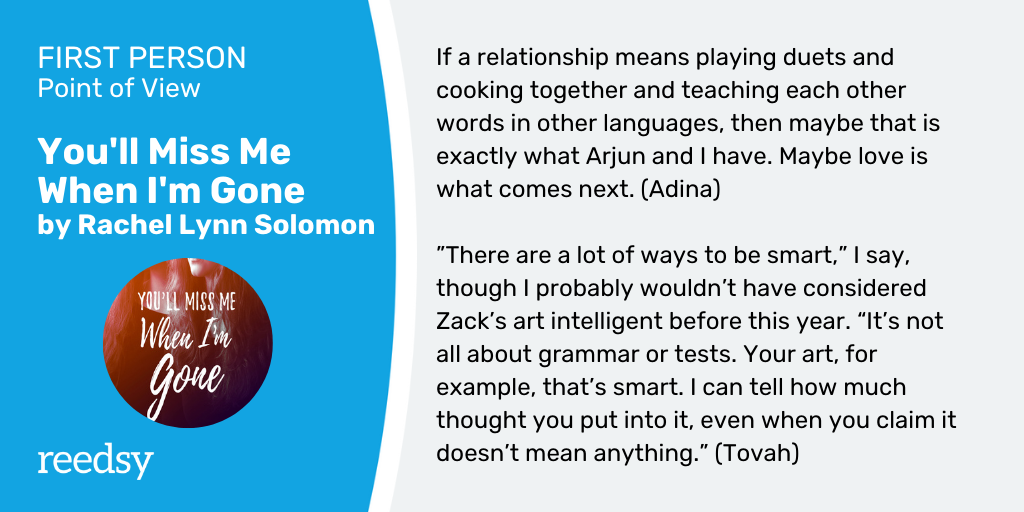 As Adina and Tovah struggle with an illness in the family, they are also young women learning about love and relationships — which they approach and try to make sense of in their own distinctive ways.
As Adina and Tovah struggle with an illness in the family, they are also young women learning about love and relationships — which they approach and try to make sense of in their own distinctive ways.
3. Awkward self-descriptions
On the other hand, if you only have one first person narrator, you may run into the problem of trying to describe them. Through the narrator's eyes, authors can easily describe every other character, the setting, and the intricate details of relationship dynamics — but they don't have a set of eyes that can turn back on the narrator. This can make them elusive to the point of becoming anonymous and utterly forgettable.
To counter this, some authors may be tempted to let the narrator describe themselves by, for instance, looking in the mirror and internally listing what they see:
As I looked in the mirror, I inspected my outfit. I was wearing a cute top and checkered skirt à la Cher from Clueless, but that's where the similarities ended. Unlike Cher, my hair was an unruly auburn mess and my features were plain. At least my combat boots and book-bag gave me a not-like-other-girls vibe, I thought.
In situations like these, it may be worth asking whether the outfit and outer appearance of the narrator significantly add to the story. Even notes on internal qualities like intelligence and personality can come off as awkward when it's the narrator describing themselves. A much better way of incorporating these elements is to employ some trusty show-don't-tell: let the plot, dialogue, and character interactions inform the reader about who the narrator is.
4. "Filtering" too much
Lastly, some authors struggle with what editor Rebecca Heyman describes as "filtering language". According to her, adding too many phrases like "I saw" and "I heard" is one of the biggest recurring mistakes in first-person prose:
If your narrator is articulating her own experience, you don't need to use structures like 'I saw' or 'I heard' — language that puts unnecessary distance between the narrator's experience and its articulation.
To avoid this, Tracy Gold suggests that you omit most thought tags and first-person dialogue tags. Your writing should already have made it clear whose point of view you're writing from, making such qualifiers unnecessary and cumbersome:
For example: 'An owl hooted softly' vs 'I heard an owl hoot softly'. One puts us inside the experience of listening; the other one just tells us about it. We know already that everything we're being told comes through the first person narration, so the character's use of empirical sense is implied.
There you have it — the ins and outs of first person point of view. If you're hungry for more, check out our next post that's all about the second person viewpoint!
What Is First Person Point of View
Source: https://blog.reedsy.com/guide/point-of-view/first-person-pov/